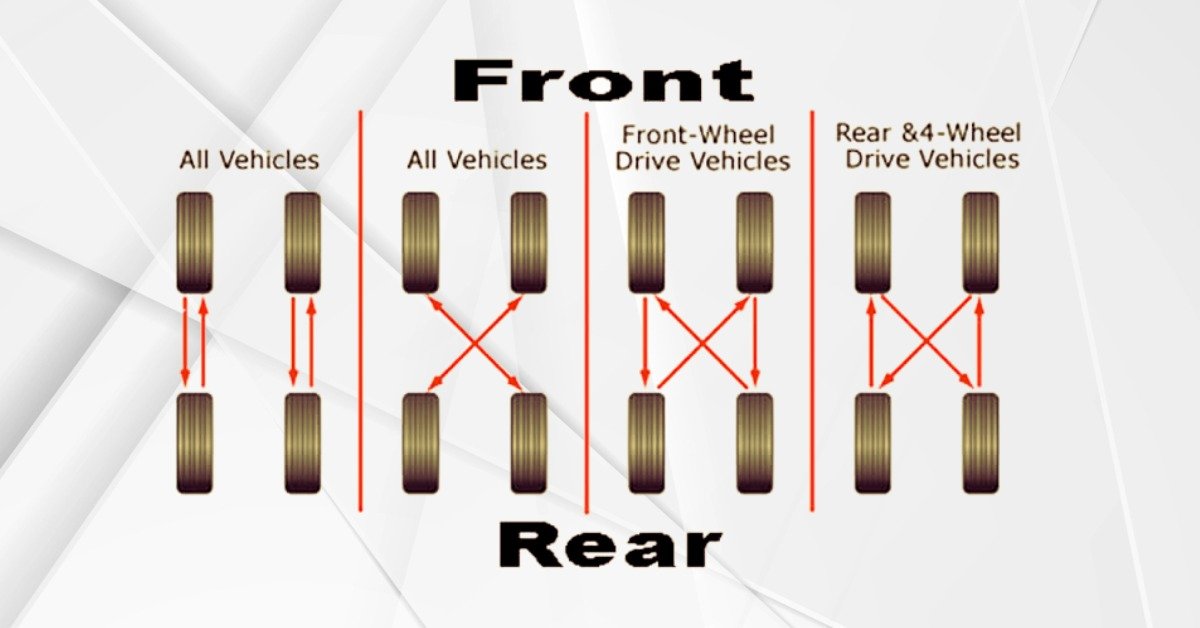Tires are one of the most critical components of your vehicle. They play a vital role in safety, fuel efficiency, and overall driving performance. One essential aspect of tire maintenance is knowing how often to rotate tires. This guide will explore the reasons behind tire rotation, the recommended frequency, and the signs that indicate it’s time to rotate your tires. Proper maintenance can enhance safety and extend the life of your tires, ensuring a smoother driving experience.
Why Tire Rotation is Important
Tire rotation is crucial for several reasons. First, it helps ensure even wear on your tires. Tires can wear differently based on their position on the vehicle. For example, front tires often wear out faster due to steering and weight distribution. Regularly rotating your tires can extend their lifespan and improve performance. By distributing the wear evenly, you not only get more miles from your tires but also enhance the grip and handling of your vehicle. This is especially important in adverse weather conditions, where tire performance is critical for safety.
Another significant reason for tire rotation is safety. Uneven tire wear can lead to reduced traction and stability, especially in wet or slippery conditions. Proper tire maintenance, including rotation, contributes to a safer driving experience. By keeping all tires in good condition, you reduce the risk of blowouts and improve overall vehicle stability.
Recommended Tire Rotation Frequency
The general rule of thumb is to rotate your tires every 5,000 to 7,500 miles. However, this can vary depending on your vehicle, driving habits, and tire type. Always refer to your vehicle’s owner manual for specific recommendations. Some manufacturers provide detailed guidelines on when to rotate tires based on tire wear patterns and vehicle design. Regularly adhering to these guidelines can significantly enhance the performance and longevity of your tires.
In addition to mileage, consider the type of driving you do. If you often drive in heavy traffic or on rough roads, you may need to rotate your tires more frequently. Likewise, if you drive a high-performance vehicle, consult the manufacturer for specific recommendations. Staying on top of your tire rotation schedule is essential for maintaining vehicle safety and performance.
Factors That Affect Tire Rotation Frequency
Several factors can influence how often you should rotate your tires. One key factor is your driving style. If you frequently drive in stop-and-go traffic, your tires may wear faster. Similarly, if you drive on rough roads or frequently make sharp turns, you might need to rotate your tires more often.
The type of tires you have also matters. High-performance tires may require more frequent rotation due to their design and compound. Additionally, the weight of your vehicle can impact tire wear. Heavier vehicles generally exert more pressure on tires, leading to faster wear. It’s also important to consider seasonal changes. In regions with distinct weather patterns, different tires may perform better during different seasons, leading to variations in rotation frequency. Keeping an eye on these factors can help you maintain optimal tire health.
Signs You Need to Rotate Your Tires
It’s important to keep an eye out for signs that indicate your tires need rotation. One obvious sign is uneven tread wear. If you notice that the tread on one side of your tires is significantly more worn than the other, it’s time to rotate. This wear pattern can affect handling and fuel efficiency, so addressing it promptly is essential.
Another sign is a change in handling. If your vehicle feels different while driving, such as pulling to one side or having vibrations, this could indicate uneven tire wear. Additionally, if you hear unusual noises while driving, such as thumping or grinding sounds, it may mean your tires need attention. Regularly inspecting your tires for these signs will help you maintain their performance and ensure a safer driving experience.
Lastly, if you notice any bulges or blisters on your tires, it’s crucial to address these issues immediately, as they can lead to blowouts.
Benefits of Regular Tire Rotation
Regular tire rotation offers numerous benefits. First and foremost, it extends the life of your tires. By ensuring even wear, you can maximize their lifespan and delay the need for replacements. This not only saves you money in the long run but also enhances your vehicle’s performance.
Another benefit is improved fuel efficiency. Properly maintained tires reduce rolling resistance, allowing your vehicle to use fuel more efficiently. This can lead to savings at the pump over time. Maintaining optimal tire pressure and regular rotation can significantly enhance fuel economy, making your vehicle more environmentally friendly.
Lastly, regular tire rotation enhances safety. By maintaining even wear and good traction, you reduce the risk of blowouts and improve your vehicle’s overall stability. Safe driving is always a priority, and ensuring your tires are in top condition is a critical part of vehicle maintenance.
How to Rotate Tires: A Step-by-Step Guide
If you’re comfortable with DIY maintenance, you can rotate your tires at home. Here’s a simple guide to help you through the process.
First, gather your tools: a jack, jack stands, a lug wrench, and a torque wrench. Make sure your vehicle is on a flat surface for safety. Next, use the jack to lift one side of your vehicle and secure it with jack stands. This is crucial for preventing accidents during the rotation process.
Once the vehicle is lifted, use the lug wrench to remove the lug nuts and take off the tires. Follow the recommended rotation pattern for your vehicle; generally, front tires move to the back, and rear tires come to the front. After rotating, place the tires back on and hand-tighten the lug nuts.
Finally, lower your vehicle back to the ground and use the torque wrench to ensure the lug nuts are tightened to the manufacturer’s specifications. Regularly rotating your tires at home can save you money and keep you informed about their condition.
Tips for Ensuring Tire Longevity
To get the most out of your tires, there are several best practices you can follow beyond regular rotation. One of the most crucial tips is to maintain proper tire pressure. Under-inflated or over-inflated tires can lead to uneven wear and reduced fuel efficiency. Check your tire pressure at least once a month, and adjust it according to the manufacturer’s recommendations found in your owner’s manual or on a sticker inside the driver’s door.
Another important practice is to perform regular visual inspections of your tires. Look for signs of damage such as cuts, punctures, or bulges. Also, check the tread depth to ensure it meets safety standards. A simple way to check tread depth is to use the penny test: insert a penny into the tread with Lincoln’s head facing down. If you can see all of Lincoln’s head, it’s time to replace the tire.
Additionally, be mindful of how you drive. Avoid sudden stops and sharp turns, which can cause uneven tire wear. Smooth driving habits not only extend the life of your tires but also enhance fuel efficiency.
Lastly, consider having your tires balanced and aligned regularly. Proper alignment prevents your vehicle from pulling to one side and helps maintain even wear. A good rule of thumb is to check alignment every 6,000 miles or if you notice handling issues.
By following these tips and staying diligent about tire maintenance, you can enhance the longevity and performance of your tires, ensuring a safer and more economical driving experience. Regular attention to your tires can save you money in the long run and keep you safe on the road.
Common Tire Rotation Patterns
There are several common tire rotation patterns to consider. The most common is the front-to-back rotation, where front tires move to the back and vice versa. This pattern works well for most vehicles, helping to distribute wear evenly. For vehicles with directional tires, a side-to-side rotation is recommended.
Some vehicles, especially those with all-wheel drive, may have specific rotation patterns that differ from standard ones. Always refer to your vehicle’s manual for the best rotation pattern tailored to your specific model. Keeping track of your tire rotation pattern can help maintain tire health and improve handling.
Regardless of the pattern you choose, regular rotation is essential for optimal tire performance and safety. This proactive approach to tire maintenance will ensure that you enjoy a smoother and safer driving experience over time.
Conclusion: Keep Your Tires in Top Shape
Understanding how often to rotate your tires is vital for maintaining your vehicle’s performance and safety. Regular tire rotation not only extends the life of your tires but also improves fuel efficiency and ensures safer driving. By keeping an eye on tread wear and following a rotation schedule, you can protect your investment and enjoy a smoother ride.
For more tire maintenance tips and guidance, be sure to check out our homepage at Try Hard Guides.
Frequently Asked Questions About Tire Rotation
How do I know when to rotate my tires?
Most manufacturers recommend rotation every 5,000 to 7,500 miles. However, check for uneven wear and handling changes.
Can I rotate my tires myself?
Yes, if you’re comfortable with basic maintenance. Just ensure you have the proper tools and follow the steps carefully.
What happens if I don’t rotate my tires?
Failing to rotate your tires can lead to uneven wear, reduced traction, and potentially dangerous driving conditions.
Are there different patterns for all-wheel drive vehicles?
Yes, all-wheel drive vehicles may have specific rotation patterns. Always consult your owner’s manual.
Is it necessary to have an alignment after rotating tires?
Not necessarily, but if you notice uneven wear or handling issues, it may be worth checking your alignment.

Alex Taylor is a seasoned writer and editor with over 5 years in digital media, specializing in practical home maintenance guides and homeowner tips. From heating system upkeep to seasonal repair checklists, Alex blends clear, relatable advice with real-world experience to help readers protect their homes and budgets. He personally reviews and fact-checks every article in his areas of expertise to ensure accuracy, clarity, and real-world usefulness. His work also spans tech, culture, fashion, sports, and lifestyle—always with a focus on clarity, relevance, and reader value.
Discover more from Try Hard Guides
Subscribe to get the latest posts sent to your email.

